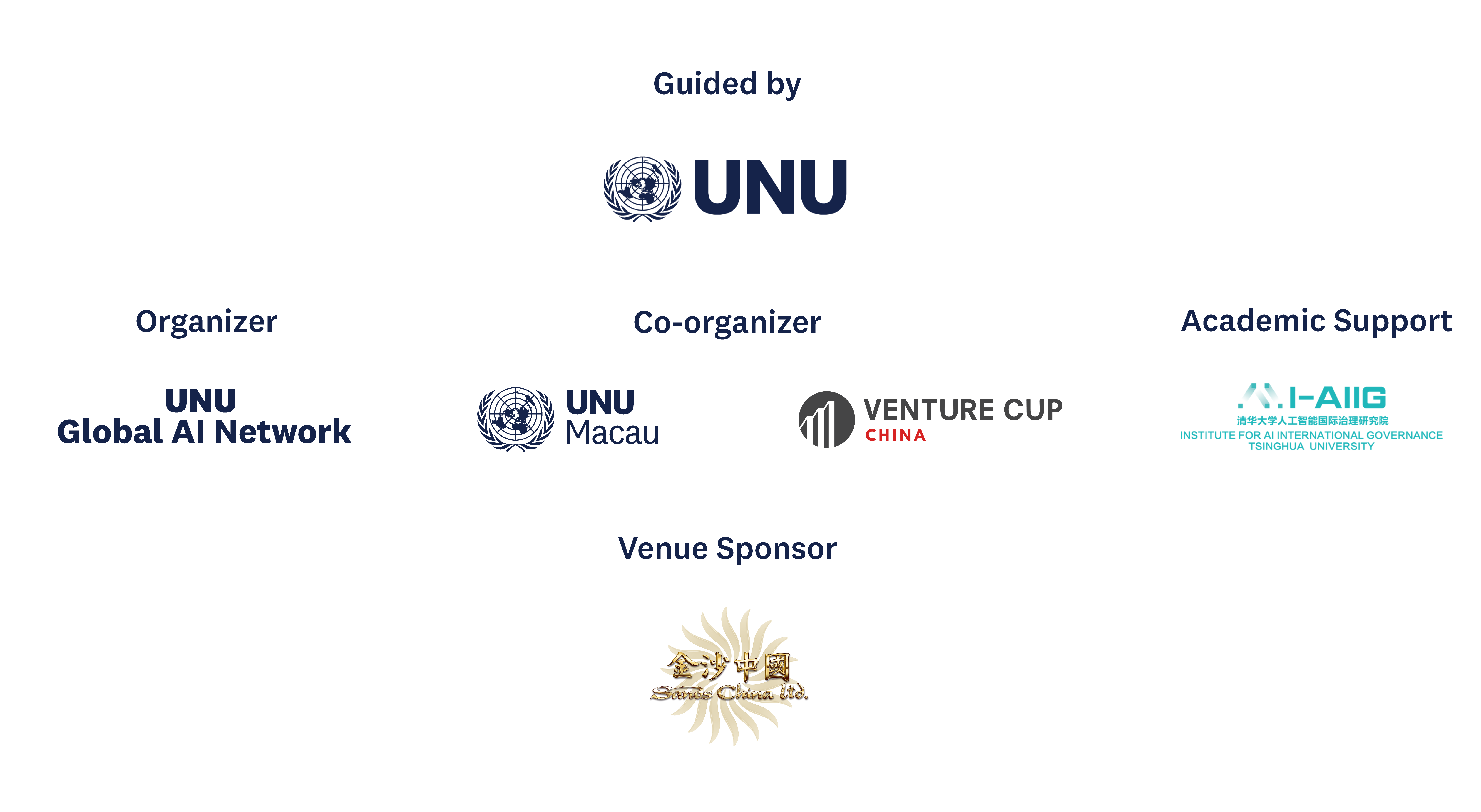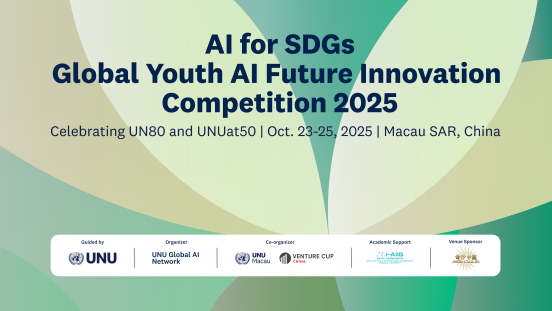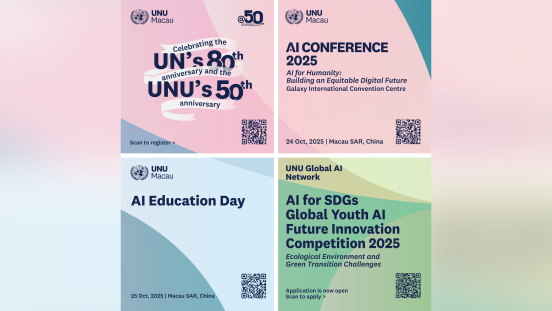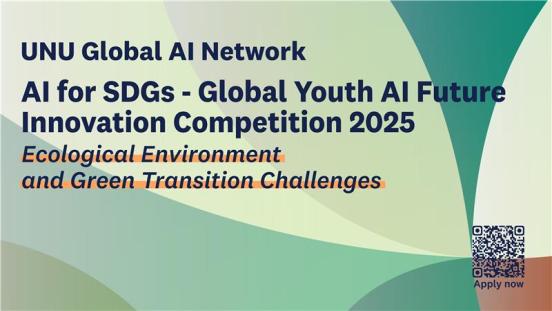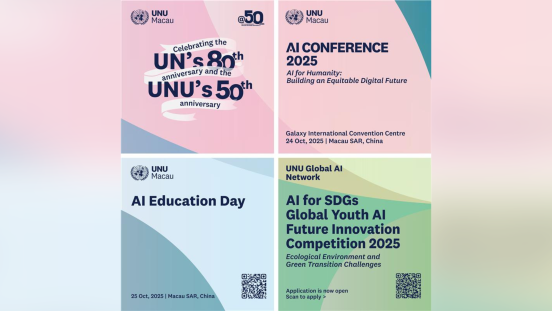The UNU Global AI Network is pleased to launch the AI for SDGs — Global Youth AI Future Innovation Competition, an international science and technology innovation competition with the goals of empowering social innovation1HideSocial innovation refers to the use of new methods, concepts or technologies to solve social problems and create positive social impacts. This type of innovation is not limited to the business or technology fields, but also covers multiple aspects such as policy making, education, environmental sustainability, social inclusion, etc., aiming to improve social welfare and promote equitable development. Social innovation also often involves cross-sector collaboration, with governments, enterprises, research institutes and communities working together to create more sustainable and inclusive social solutions., advancing youth development, and addressing sustainable development challenges through artificial intelligence (AI).
Each year, the competition will focus on a major theme, with tracks dedicated to specific areas. The inaugural theme for 2025 is AI for the Environment: Ecological Environment and Green Transition Challenges, with tracks on:
- Climate Change Adaptation
- Environmental Protection and Conservation
- Clean Energy
- AI for Less Developed Countries
The competition will feature innovative solutions with high technology readiness levels (TRL), ready for commercialization in China.
A comprehensive growth-support package, including financial support, industry and investment matchmaking, and international promotion, will be provided to the winning teams. In addition to a monetary award, the winners will have the opportunity to pilot their solutions in China, fostering real-world applications of their technology.
A special Macau Prize will recognize exceptional entries from Macau, reinforcing the region’s role in fostering social innovation and youth engagement in sustainable development.
The jury will consist of renowned academics, industry professionals, and institutional investors from global institutions.
Featured
Competition Tracks
2025 Theme: Ecological Environment and Green Transition Challenges
1. Climate Change Adaptation
- Focus: using AI to predict climate change impacts and enhance resilience of societies and ecosystems.
- Key AI applications: extreme weather prediction, early warning systems, disaster response and recovery, climate-smart agriculture, water resource management, public health and climate related disease control, ecosystem and biodiversity resilience, food security, use social media data to better understand people’s reactions in the case of disaster risks to understand the effects on mental health, urban climate resilience planning, developing AI tools specifically for informal settlements to measure maximum temperature and precipitation, automated differential vulnerability analysis, Customized ML for urban adaptation baselines, optimization of irrigation, pest control, and crop selection under shifting climate conditions, adaptive infrastructure design for flood-prone cities and small Islands, detection and prediction of maladaptation, etc.
- SDG References: SDG 13, SDG3, SDG 2, SDG 6, SDG 11, and SDG 15.
2. Environmental Protection and Conservation
- Focus: using AI to enhance monitoring, resource management, protection, conservation, and mitigation strategies for the environment.
- Key AI applications: wildlife conservation, contamination tracing and treatment, smart waste management, and circular economy, granular dynamic sector/region specific carbon emission dashboard; AI based life cycle cost benefit models for conservation, AI-enabled camera traps, track endangered species, deforestation via satellite imagery (e.g., Global Forest Watch), oil spills (e.g., NASA’s SAR-based spill detection) and optimize wastewater treatment, use satellite to detect if cotton for example is being irrigated with pesticides. Computer vision systems (e.g., Bin-e) automate recycling sorting, and AI predicts landfill capacity (e.g., Greyparrot’s waste analytics), minimize waste in supply chains.
- SDG References: SDG 15, SDG 14, and SDG 13.
3. Clean Energy
- Focus: using AI to enhance renewable energy efficiency and accelerate the low-carbon transition of energy systems.
- Key AI applications: smart grids and energy prediction, energy storage system (ESS) optimization, AI based IoT driven off grid clean energy systems, and new energy material R&D.
- SDG Reference: SDG 7.
4. AI for Less Developed Countries
- Focus: using AI to develop affordable and accessible technology to support climate adaptation and green transition in less developed countries.
- Key AI applications: smart supply chain optimization, low-cost manufacturing technology, climate-resilient infrastructure and AI for leapfrogging capacities of key stakeholders to advance NAPs implementation.
- SDG References: SDG 9 and SDG 10.
Requirements
- Companies, organizations, groups and individuals from all around the world may register. There are no restrictions based on background or nationality.
- The technology maturity of the participating projects must be above Technology Readiness Level (TRL) 6 2HideThat is, TRL 7-9. TRL 7: System prototypes are validated in real-world scenarios. TRL 8: Systems are completed and tested, ready for commercialization. TRL 9: The technology is successfully applied to real-world scenarios and commercialization is complete., meaning they have completed the laboratory stage, meet the conditions for on-the-ground validation in real-world scenarios, have the technology readiness level that is close to commercialization, and have a certain degree of innovation and market potential.
- For projects from an established enterprise, the company should have been founded less than 10 years.
- Applications and accompanying materials must be submitted in English, and the evaluation will also be conducted in English.
- There are no registration, training, or any other fees for participation in the competition.
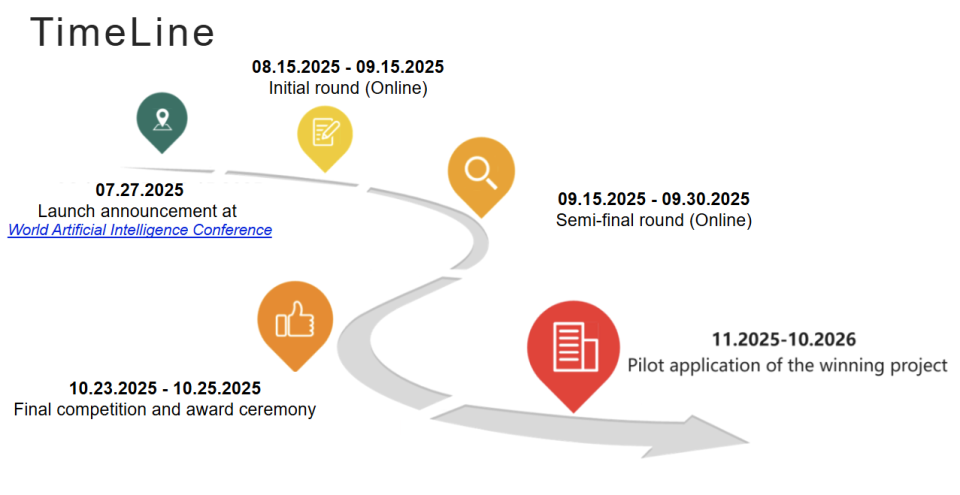
Timeline
The Global Youth AI Future Innovation Competition 2025 will be held in three stages: the initial round, the semi-final round, and the final round. The initial schedule is as follows:
- Official Launch Ceremony: July 27, 2025 at the World Artificial Intelligence Conference in Shanghai, click to apply.
- Initial Round: August 15, 2025 - September 15, 2025 (Online)
- Semi-Final Round: September 15, 2025 - September 30, 2025 (Online)
- Final Round and Award Ceremony: October 23-25, 2025, the final competition will take place, followed by the award ceremony in Macau.
- Cash award to each category-winning team: 1000 USD per team (before tax).
- The winning teams will have the opportunity to pilot their project in China from November 2025 to October 2026.
Organization Structure
Guided by: United Nations University
Organizer: UNU Global AI Network
Co-organizer: UNU Macau, Venture Cup China
Exclusive Academic Support: Institute for AI International Governance of Tsinghua University
Outreach Partners: Members of the UNU Global AI Network
Contact us
Contact us for more information at ai4sdgs@venturecup.cn ainetwork@unu.edu
You may download information about the competition in PDF format from below:
AI for SDGs — Global Youth AI Future Innovation Competition 2025 Leaflet
AI for SDGs — Global Youth AI Future Innovation Competition 2025 Slides
Application Closed on Aug. 31, 2025
